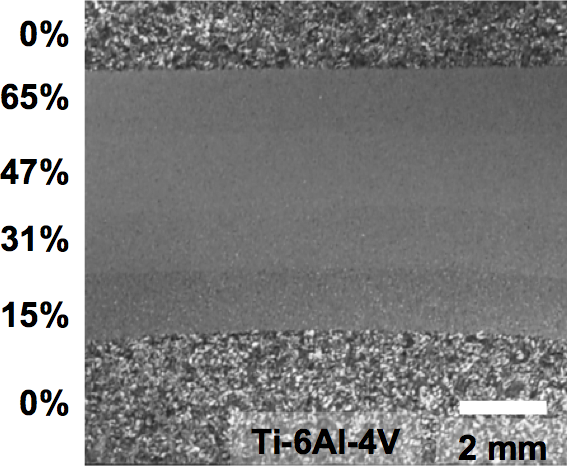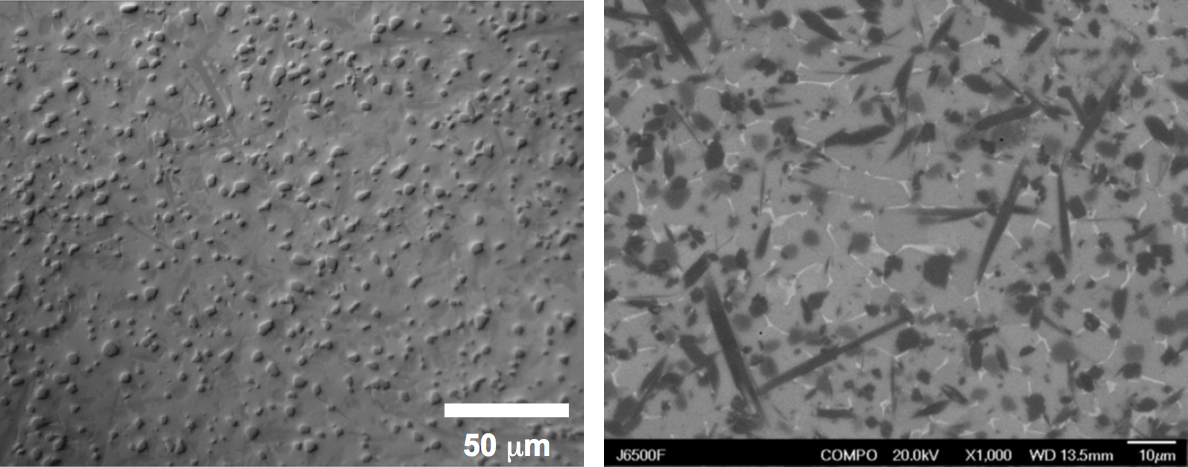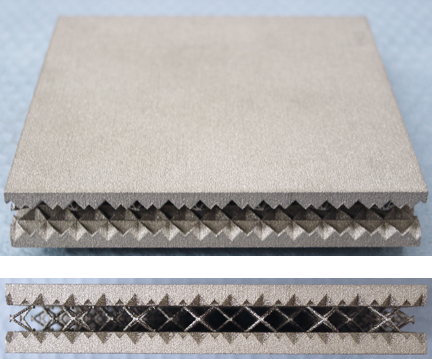Functionally and Geometrically Ordered Ti Armor
Design and Processing of Ti Composite Armors
2: Titanium Composite Processing
We utilize newly available low-cost titanium powders, solid state powder metallurgy consolidation methods, and the recently installed state-of-the-art direct manufacturing capabilities at ORNL to investigate titanium/ceramic composite material fabrication and properties. Computer modeling is used in an iterative process to aid in the design of the composite structures and to predict material properties. Two manufacturing techniques are used:
Functionally Graded Composites
Powder processing provides a method for producing a composite system that could combine the desirable properties of an armor ceramic (high compressive strength, very high hardness, and light weight) with the excellent structural properties of consolidated titanium, forming an exceptional structural material that incorporates enhanced ballistic protection capabilities. Considered ceramic materials include boron carbide (B4C) and silicon carbide (SiC), two of the current monolithic ceramic armor materials. In addition, titanium diboride (TiB2) is also investigated. It is chemically compatible, and both the specific gravity and the thermal expansion coefficient are a good match with Ti-6Al-4V. The ceramic content of the composites may be continuously graded through the titanium matrix or concentrated locally in desired areas, such as near the impact surface.

|
Functionally graded armor tiles can be produced by layering titanium and ceramic powder blends having different metal-to-ceramic ratios. The layers are then consolidated into a solid laminated structure by hot pressing. These graded armor tiles have been shown to significantly improve ballistic penetration resistance. A macro-photograph of the cross-section of a graded composite structure of titanium and ceramic is shown in the figure below.

|

|
Complex geometric arrangements are also possible, especially when utilizing the direct manufacturing capabilities at ORNL, which include a Precision Optical Manufacturing (Auburn Hills, MI) laser deposition system and an Arcam AB (Sweden) electron beam deposition system. Our assumption is that the geometrical patterning in the armor material can interact with the shock wave that is generated upon impact and enhance ballistic performance. Various combinations of metal-to-ceramic ratio and particle distribution have been studied.
Armor tiles having a complex geometric interface between titanium and a titanium/ceramic composite material can be produced using a combination of direct manufacturing and hot pressing. An example of such a structure is shown below, where an ARCAM system was used to construct a Ti-6-4 structure directly from a CAD file. The gap in the structure was subsequently filled with titanium/ceramic composite powder and then hot pressed to consolidate and bond the layers of the armor tile.

|
The overall plate has a complex geometric pattern on the internal surfaces. The edge view shows the gap formed by wire ligaments.
The image below shows a cross-section of the armor tile after the gap was filled with composite material and hot pressed to fully consolidate the layered structure.

|
Measurements of hardness and strength are used as indicators of ballistic penetration resistance, but ultimately the armor performance is judged by ballistic impact tests, which is conducted by ORNL and Wackenhut personnel at the Central Training Facility. We are aiming for a minimum improvement in Em from 1.5 to 2.0. This corresponds to a weight reduction of 50% compared to RHA steel and 25% when compared to conventional wrought Ti plate.
Hybrid Composites
Most advanced armor systems utilize combinations of dissimilar, but complimentary, materials to achieve optimal performance. For instance, soldier body armor incorporates a ceramic plate that is backed by several layers of a ballistic fabric, such as Kevlar. However, combining Ti metal with ceramic plates in an integrated structural system has several complications if attempted while using conventional melt processing. Chemical reactivity, differences in specific gravity, and a thermal expansion mismatch between the metal and ceramic can make fabrication of sound hybrid composites very difficult, if not impossible. Most of these incompatibility issues can be eliminated by using Ti powder and processing in the solid state. The presence of the solid ceramic will blunt and possibly fracture the incoming projectile as it strikes the plate surface, thus requiring much more work energy to be expended by the projectile in the process of trying to pierce the remaining titanium/ceramic structure. We are investigating performance of variations of the layered hybrid composite such as: a surface layer of ceramic, a single ceramic layer embedded in a titanium matrix, and multiple alternating layers.

|
All of these variations incorporate geometric patterning, either in layer placement or at layer interfaces. Computational studies are used to develop the layered systems, including the incorporation of graded interfaces and beneficial residual stresses in the structures. Testing and evaluation are similar to the methods used for the functionally graded composites.